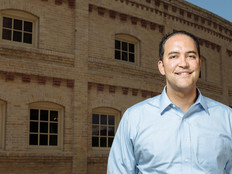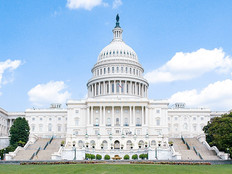How the MGT Act Will Spur Agencies' IT Investments in 2018 and Beyond
The moment that the federal IT community has been waiting on for over a year came on the afternoon of Dec. 12, as President Donald Trump signed the Modernizing Government Technology Act into law.
The IT modernization legislation, passed as an amendment to the 2018 National Defense Authorization Act, could spur agency migration to the cloud, shutter legacy systems and allow for investments in new technologies.
Now, agencies will likely assess how they might use the working capital funds the legislation authorizes to reprogram their IT budgets and fund modernization projects. Each agency has its own technology priorities and it will likely take some time for the law to bear fruit. The law also creates a centralized Technology Modernization Fund that the administrator of the General Services Administration will manage (on Dec. 12, the Senate confirmed Emily Murphy to that role).
“To go implement this, it will take all hands on deck,” Tony Scott, who served as federal CIO in the Obama administration, told The Hill.
Rep. Will Hurd, one of the law’s chief proponents in Congress, noted in a statement that every year the government “wastes billions of hard-earned taxpayer dollars maintaining outdated, unreliable and unsecured IT systems — some of which were first designed in the 1960s,” but that the law will spark change.
“The MGT Act will bring the government’s IT systems into the 21st century and allow agencies to use the money that is saved to modernize other systems, helping create more quality and timely services to the American people,” Hurd said.
SIGN UP: Get more news from the FedTech newsletter in your inbox every two weeks!
Working Capital Funds to Spur IT Modernization
Under the law, the head of each agency can establish working capital funds for IT modernization (some agencies already do so). Agencies can transfer and reprogram funds, including for the operation and maintenance of legacy IT systems, and then use the money for a variety of projects.
The funds can be used to improve, retire or replace existing IT systems to enhance cybersecurity and to improve efficiency and effectiveness; transition legacy IT systems to cloud or shared services; adopt risk-based cybersecurity solutions; or to reimburse a central modernization fund the law sets up.
The head of each agency must prioritize funds within the IT working capital fund of the covered agency to be used initially for cost savings activities approved by the agency’s CIO, and may reprogram and transfer any amounts saved as a direct result of the cost savings activities back into the working capital fund. The funds will be available for a three-year period beginning on the last day of the fiscal year in which the funds were deposited.
No later than Dec 12, 2018, and every six months thereafter, the head of each agency must submit to the director of the Office of Management and Budget a list of each IT investment that has been funded, including the estimated cost and completion date for each investment. They also must submit a summary by fiscal year of obligations, expenditures and unused balances. Those reports will be publicly available.
The law also creates a centralized IT modernization the GSA will manage. The law authorizes $250 million for the fund for fiscal year 2018 and the same amount for fiscal year 2019. Agencies can apply to get money from the fund to modernize their IT and make it more efficient and secure.
A board of government officials will advise the OMB director on agencies’ proposals. Agencies must reimburse the fund. The OMB director must also, at least quarterly, make public a list that includes a description of the projects funded, the project status (including any schedule delay and cost overruns), financial expenditure data related to the project and the extent to which the project is using commercial products and services (including if applicable, a justification of why commercial products and services were not used and the associated development and integration costs of custom development).
Cloud Services Likely to Boom Under MGT Act
What kinds of projects will the MGT Act allow agencies to take on? Federal IT experts say the cloud will be a clear winner.
Davis Johnson, vice president of the U.S. public sector at Riverbed Technology, says that the MGT Act represents a “high-level way for the government to accelerate migration to the cloud, save money and allow agencies to get access to the money they save to do really cool things that they otherwise couldn’t do.”
Johnson thinks some of those “really cool things” will include network modernization projects that will give agency CIOs more visibility into what is happening on their networks.
Network modernization “has been an afterthought for the last 10 years,” Johnson says, adding, “there has been a ton of activity around data center modernizations, and server and storage virtualization. Network got left behind.”
There will likely be a lot of “proof of concept” MGT Act projects next year, Johnson says, but IT modernization will then take off in 2019.
Dave Wennergren, managing director at Deloitte and a former deputy CIO of the Defense Department and vice chair of the federal CIO Council, says the MGT Act “is a long time coming” and comes as the Trump administration’s American Technology Council released a report on IT modernization (a final version should be published soon following public comments). The executive and legislative branches of government are now pushing for IT modernization and for agencies to use more commercial IT solutions, Wennergren says.
The MGT Act gives agency CIOs “top cover” to pursue modernization, “but even better than that it gives a mandate and requirement to report back on your progress.”
Agencies that do not have the internal resources to do IT modernization via their own working capital funds will likely apply to the GSA fund, Wennergren says.
The vast majority of federal IT money goes toward maintaining legacy computers, networks and the applications that run on them, Wennergren notes. With the administration and Congress pushing, agencies will hopefully take a deliberate but not overly long look at their IT and see where they can get the most value out of modernization, he says.
Moving to the cloud will likely be a key area, since it is more cost-effective and allows them to get access to innovative solutions that are continually added to cloud platforms, according to Wennergren. That will allow agencies to shutter data centers filled with legacy hardware. Agencies will also likely look to rationalize legacy systems and for ways to use digital technology to improve citizen services.









